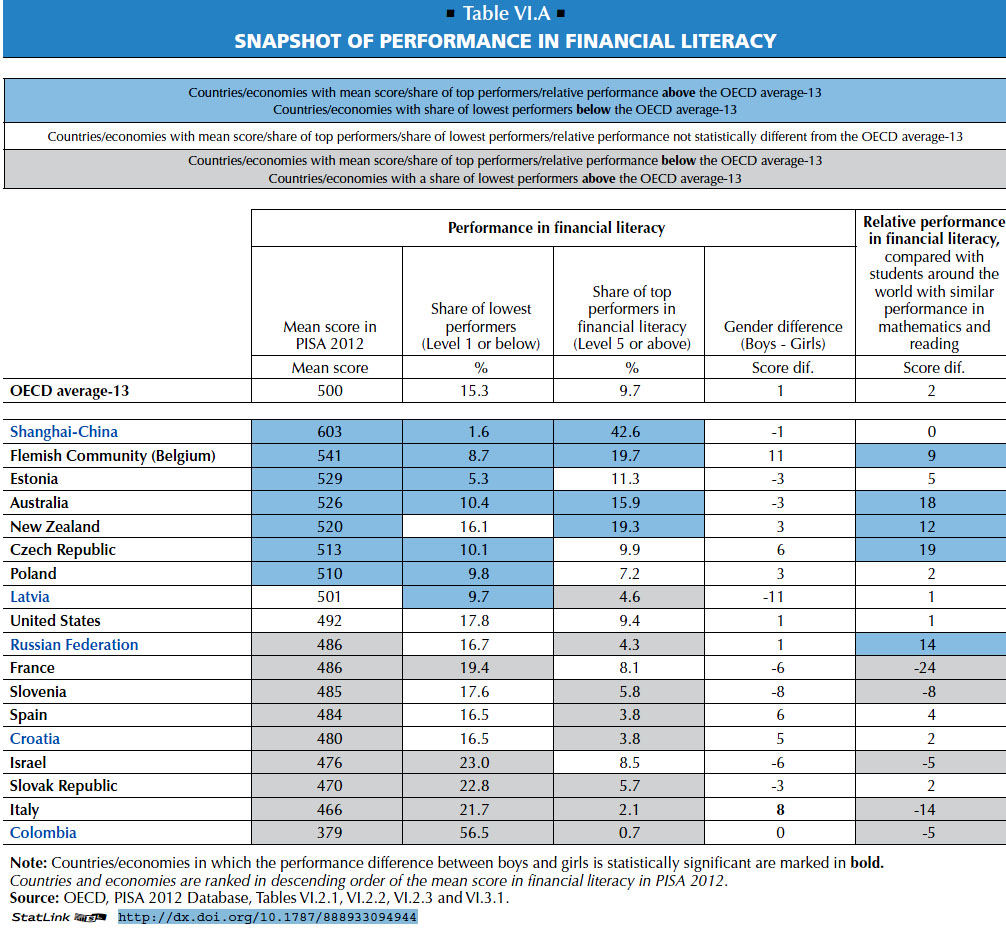Students and Money: Financial Literacy Skills for the 21st Century – Volume VI ©
OECD 2014 13Finance is a part of everyday life for many 15-year-olds: they are already consumers of financial services such as bank accounts with access to online payment facilities. As they near the end of compulsory education, students will also face complex and challenging financial choices. One of their first major decisions may be to choose whether to continue with formal education and how to finance such study.
Financial literacy is thus an essential life skill, and high on the global policy agenda. Shrinking welfare systems, shifting demographics, and the increased sophistication and expansion of financial services have all contributed to a greater awareness of the importance of ensuring that citizens and consumers of all ages are financially literate. Some governments have started developing strategies and policies to improve financial literacy. The financial literacy assessment in PISA 2012 offers the first ever international assessment of the financial knowledge and skills of 15-year-old students. A second assessment is planned for PISA 2015, which will make it possible to monitor change and provide further evidence on the design and implementation of policies to enhance financial literacy.
This volume reports the results of the PISA 2012 financial literacy assessment, which was administered to approximately 29 000 students in 13 OECD countries and economies (Australia, the Flemish Community of Belgium, the Czech Republic, Estonia, France, Israel, Italy, New Zealand, Poland, the Slovak Republic, Slovenia, Spain and the United States) and five partner countries and economies (Colombia, Croatia, Latvia, the Russian Federation and Shanghai-China), representing 40% of world GDP.
Shanghai-China has the highest average score in financial literacy, followed by the Flemish Community of Belgium, Estonia, Australia, New Zealand, the Czech Republic and Poland. On average, all of these score above the average for the participating OECD countries and economies.
There are wide differences in average performance between the highest- and lowest-performing countries and economies: more than 75 score points (a full PISA proficiency level) among OECD countries and economies, and more than 225 score points across all participants. Yet only a small proportion (16%) of the variation among countries’ mean financial literacy scores is explained by per capita GDP.
Only one in ten students across participating OECD countries and economies is able to tackle the hardest financial literacy tasks in PISA 2012.
They can analyse financial products involving features that are not immediately evident, such as transaction costs, solve non-routine financial problems such as calculating the balance in a bank statement while accounting for transfer fees, and demonstrate an understanding of the wider financial landscape, such as the implications of income-tax brackets.
In contrast, 15% of students, on average, score below the baseline level of performance in the PISA financial literacy scale. At best, these students can recognise the difference between needs and wants, make simple decisions about everyday spending, recognise the purpose of common financial documents, such as an invoice, and apply single and basic numerical operations (addition, subtraction or multiplication) in contexts that they are likely to have encountered personally.
Students in some countries that perform well in financial literacy, such as Australia, the Czech Republic, Estonia, the Flemish Community of Belgium and New Zealand, score higher in financial literacy, on average, than their performance in mathematics and reading would predict.
In contrast, in France, Italy and Slovenia, students’ performance in financial literacy is relatively low, on average, when compared with students in all participating countries and economies who have similar proficiency in mathematics and reading. Thus, although financial literacy skills are positively correlated with mathematics and reading skills, high performance in one of those core subjects does not necessarily signal proficiency in financial literacy.
Across the 13 participating OECD countries and economies, the difference between the highest-achieving 10% of students and the lowest-achieving 10% is 247 score points.
On average, 37% of performance differences in financial literacy within countries are observed between schools – a significant proportion, but smaller than that observed in mathematics and reading.
A more socio-economically advantaged student scores 41 points higher in financial literacy than a less advantaged student, on average across participating OECD countries and economies.
Estonia is the only participating country that combines above-average performance with a weaker-than-average association between financial literacy performance and socio-economic status. On average across OECD countries and economies, non-immigrant students perform slightly better in financial literacy than immigrant students with similar socio-economic status, language spoken at home, and performance in mathematics and reading. The gap in financial literacy performance between immigrant and non-immigrant students is larger than the OECD average in the Flemish Community of Belgium, Estonia, France, Slovenia and Spain.
Gender gaps in financial literacy among 15-year-olds are small, unlike those found in adult populations.
In all participating countries and economies, except Italy, there are no differences in average financial literacy scores between boys and girls. Across OECD countries and economies, there are more top-performing boys than girls, and more low-performing boys than girls, in financial literacy.
In Australia, the Flemish Community of Belgium, Estonia, France, New Zealand and Slovenia, more than 70% of 15-year-old students hold a bank account; but in Israel, Poland and the Slovak Republic, fewer than 30% do.
In 9 out of 13 OECD participating countries and economies, after adjusting for socio-economic status, students who hold a bank account perform as well as those who do not, while in the Flemish Community of Belgium, Estonia, New Zealand, and Slovenia, students who hold a bank account score higher in financial literacy than students of similar socio-economic status who do not.
Students’ attitudes towards learning, such as perseverance and openness to problem solving, are positively associated with financial literacy.
On average across OECD countries and economies, the difference in financial literacy performance between students who agreed with the statement “I like to solve complex problems” and students who disagreed is equal to 31 score points, or almost half a proficiency level.
 http://dx.doi.org/10.1787/888933094944
http://dx.doi.org/10.1787/888933094944